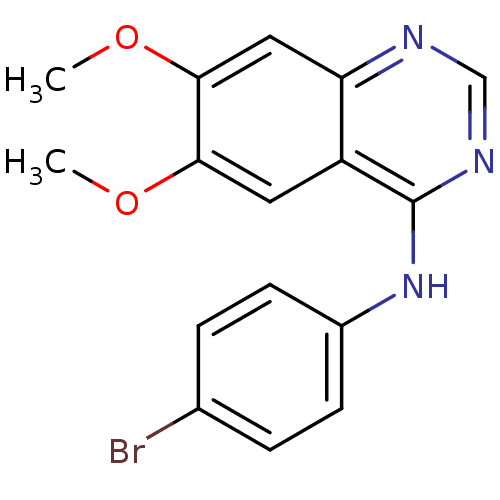

 Search and Browse
Search and Browse
 Download
Download
 Enter Data
Enter Data
BDBM3567 CHEMBL328106::N-(4-bromophenyl)-6,7-dimethoxyquinazolin-4-amine::PD153035 Analog 67
SMILES: COc1cc2ncnc(Nc3ccc(Br)cc3)c2cc1OC
InChI Key: InChIKey=MCNVTWIIWNZMGB-UHFFFAOYSA-N
Data: 4 IC50
| Target/Host (Institution) | Ligand | Target/Host Links | Ligand Links | Trg + Lig Links | Ki nM | ΔG° kcal/mole | IC50 nM | Kd nM | EC50 nM | koff s-1 | kon M-1s-1 | pH | Temp °C |
|---|---|---|---|---|---|---|---|---|---|---|---|---|---|
| Epidermal growth factor receptor (Human) | BDBM3567 (CHEMBL328106 | N-(4-bromophenyl)-6,7-dimethoxyquin...) | GoogleScholar | UniChem | n/a | n/a | 0.960 | n/a | n/a | n/a | n/a | n/a | n/a | |
TBA | Citation and Details | ||||||||||||
| More data for this Ligand-Target Pair | |||||||||||||
| Epidermal growth factor receptor (Human) | BDBM3567 (CHEMBL328106 | N-(4-bromophenyl)-6,7-dimethoxyquin...) | GoogleScholar | UniChem | n/a | n/a | 0.0724 | n/a | n/a | n/a | n/a | n/a | n/a | |
TBA | Citation and Details | ||||||||||||
| More data for this Ligand-Target Pair | |||||||||||||
| Epidermal growth factor receptor (Human) | BDBM3567 (CHEMBL328106 | N-(4-bromophenyl)-6,7-dimethoxyquin...) | GoogleScholar | UniChem | n/a | n/a | 3.60E+3 | n/a | n/a | n/a | n/a | n/a | n/a | |
TBA | Citation and Details | ||||||||||||
| More data for this Ligand-Target Pair | |||||||||||||
| Vascular endothelial growth factor receptor 2 (Human) | BDBM3567 (CHEMBL328106 | N-(4-bromophenyl)-6,7-dimethoxyquin...) | GoogleScholar | UniChem | n/a | n/a | 800 | n/a | n/a | n/a | n/a | n/a | n/a | |
TBA | Citation and Details | ||||||||||||
| More data for this Ligand-Target Pair | |||||||||||||